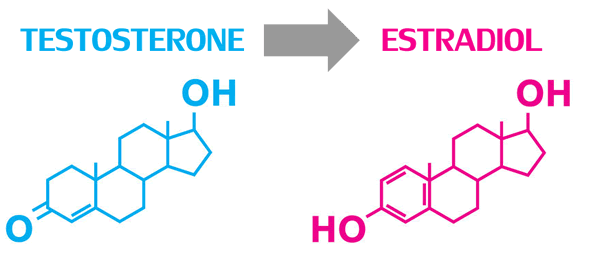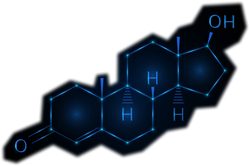Estradiol, the predominant form of estrogen, also plays a critical role in male sexual function. Estradiol in men is essential for modulating libido, erectile function, and spermatogenesis. Too little estrogen can predispose men to osteoporosis and lead to bone fractures. Slightly elevated levels double a man’s risk of stroke and even higher incidence of coronary artery disease. Men with higher blood estrogen levels may be at higher risk for enlarged prostate or prostate cancer, especially if they have low free testosterone blood levels. Men with even slightly elevated estrogen levels doubled their risk of stroke and had far higher incidences of coronary artery disease. Men presenting with benign prostate enlargement or prostate cancer also have higher blood estrogen levels.

Links to Heart Failure in Men
Very high estrogen (estradiol) levels and low testosterone levels are common in men with chronic heart failure and is associated with increased morbidity and mortality. Extremely low levels of estradiol is also problematic, as estradiol has beneficial effects on the myocardium (a thick middle layer between the outer layer of the heart wall) and vasculature (the distribution of blood vessels in the heart). This is why a man's body has evolved to convert small amounts of testosterone to estradiol; there should be a perfect balance.
Reducing Aromatase Activity
Aging men sometimes have too much aromatase activity, which causes their testosterone to convert to excess estradiol. This results in depletion of vital testosterone while spiking estradiol to unsafe ranges. There are certain foods that help to block this conversion:
- Celery stalks (organic is important as normal celery contains many pesticide residues)
- Red wine (in moderation). Pinot Noir is the best aromatase inhibitor.
- Organic virgin olive oil.
- White Button Mushrooms.
- Oysters. Oysters contain zinc which is a strong aromatase inhibitor.
- Cruciferous Vegetables (broccoli, cabbage, kale, sprouts). Contains3,3′-Diindolylmethane (DIM) which is has estrogen lowering properties.
- Parsley. This contains apigening which inhibits aromatase. Parsley also stimultes testosterone production in the testicular leydig cells and contains nitric oxide producing nitrates (a key chemical trigger for erections)
Amazing cabbage
Cabbage is full of a chemical called indole-3-carbinol (I3C) which reduces your blood estrogen hormones (great if you are a guy and also great if you are a women and want to reduce the risk of breast cancer). Indole-3-carbinol is produced by the breakdown of the glucosinolate glucobrassicin, which can be found at relatively high levels in cruciferous vegetables such as broccoli, cabbage, cauliflower, brussels sprouts and kale. It is also available as a dietary supplement. Cabbage contains the antioxidants choline, beta-carotene, lutein, and zeaxanthin as well as the flavonoids kaempferol, quercetin and apigenin. Studies show that I3C stimulates detoxifying enzymes, helping to eliminate toxins and harmful forms of estrogen that can lead to cancer. Boiling cabbage for 10 minutes doesn’t have a huge effect on I3C (80% level remains).
Diindolylmethane (DIM) is a major digestive product of indole-3 carbinol (DIM is formed naturally when I3C is broken down in the gut). DIM has potent effects on estrogen metabolism and is able to keep the bodies estrogen balanced. In small amounts, it can both inhibit the aromatase enzyme (and prevent conversion of testosterone into estrogen) and it can act on more potent forms of estrogen and convert them into less potent forms; this conversion reduces the overall effects of estrogen in the body. Taking too much DIM at once boosts the aromatase enzyme and increases the testosterone to estrogen synthesis. Supplementing our diets with DIM can shift the production of estrogen metabolites away from dangerous 16-hydroxy in favour of beneficial 2-hydroxy metabolites. The amount of cabbage needed to be consumed is large. DIM female dosage is 100-300mg per day. To attain this amount of DIM you would need to eat 500g of cabbage, broccoli or cauliflower, Brussels sprouts and green cabbage daily. Male dosage is slightly higher.
Advice: Men should take an estradiol test (estrogen), if levels are above average then you might consider supplementing with DIM (it is widely available). This is also applicable if symptoms of estrogen are present such as man-boobs, low libido, decreased morning erections, decreased erectile function). remember that way too much DIM can have the reverse effect and boost estrogen. You can also buy I3C supplements but these should be avoided due to side-effects at high doses, I3C can also transform into many other non-DIM substances. The Bioresponse DIM Supplement looks very good, sourced from the US. A supplemental dose of approximately 100mg DIM seems a sensible option.
In a study, men took I3C 500mg daily for a week and their oestrogen levels halved, making testosterone more effective.
Men experience a tendency to gain weight in midlife. Rising estrogen production can result, since fat cells contain the aromatase enzyme that converts testosterone into estrogen. Unmetabolised estrogen creates a vicious cycle resulting in further estrogen production. This occurs because fat is one source of more active aromatase enzymes (that converts testosterone to estrogen), causing further estrogen production and continuing weight gain. DIM reduces excess estrogen production associated with obesity and male aging. Besides weight gain, another aspect of early aging in men is prostate gland enlargement. Estrogen accumulates in aging prostate glands at the same time enlargement occurs.

